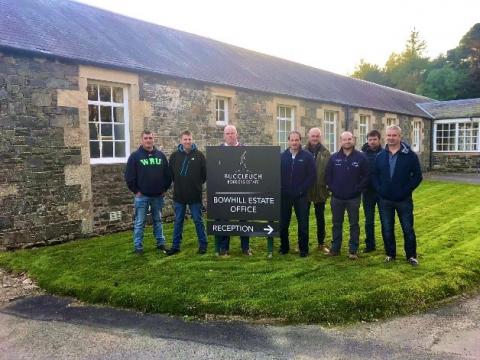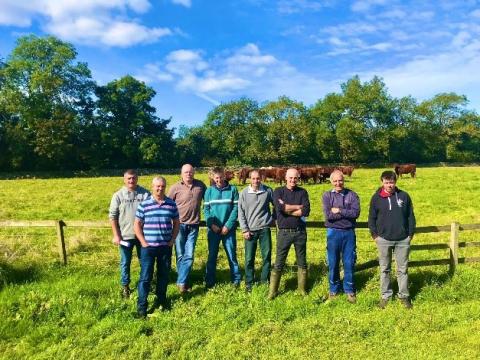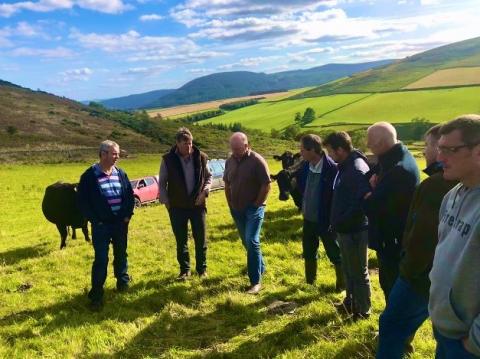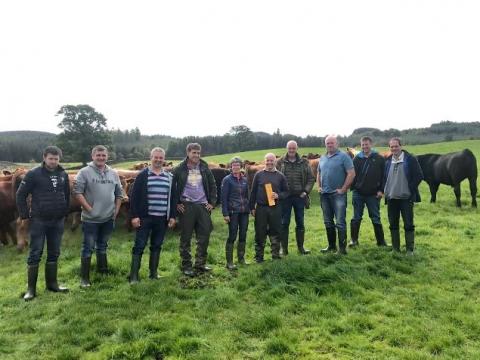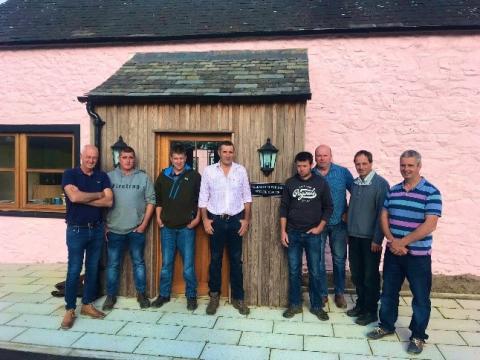Farming Connect Study Visit - Conwy Valley Cattle Group
Conwy Valley Cattle Group
Scotland
15 - 18 September 2019
1 Background
The members who attended this study visit are part of a discussion group established in 2016. This group focuses specifically on the suckler herd. With the increasing costs involved in keeping a suckler herd, this group is considering ways of improving profitability, efficiency and the future of the suckler herd on their farms. This is done by means of internal discussions as well as visits to various systems around the UK. The Scottish landscape is very similar to the Welsh one, and therefore, the members were very keen to see how those farms adapt their systems, in terms of changing breeds, changing wintering systems and much more.
2 Timetable
2.1 Day 1
Sion Williams, Bowhill Estate, Selkirk TD7 5ET
Bowhill Estate’s System
The Bowhill Estate’s system includes:
- 6,800 breeding ewes across 7 different enterprises. Ewe lambs are kept as breeding replacements and all the male lambs are finished.
- 500 suckler cows. Heifers are kept as breeding replacements. Most beef cattle are sold as stores.
- 15ha of winter barley, 63ha of spring barley, 10ha of spring oats and 46ha of kale.
- 200kW anaerobic digester machine producing 160kW from livestock manure. This has reduced the amount of chemical fertilizer used from 251 to 65 tonnes.
- Deer farming. 237 breeding animals are kept, and the aim is to increase this to 400 in the future. Meat is produced for Waitrose on a 12-month fixed-price contract.
Main messages
- The importance of measuring for management purposes was emphasised. Records must be kept in order to drive the business forward, and that should be done by designating costs for each enterprise in order to know whether those enterprises are profitable. Running a loss-making enterprise which depends on other enterprises within the businesses to keep it going is pointless.
- Targets must be set for the business. By recording data, weaknesses can be identified, and this can then become the basis for Key Performance Indicators (KPIs) when forward-planning for the future.
- It is essential to make the most of technology to record, reduce costs and facilitate day-to-day work.
- It is essential to make the most of pasture and ensure that the appropriate infrastructure is in place to manage, grow and use grass efficiently.
- Farm waste can be used. This example of an aerobic digester machine which produces 160kW of electricity from livestock manure means that chemical fertiliser costs are reduced.
2.2 Day 2
Giles Henry, Oakwood Mill, Selkirk TD7 5EZ
Oakwood Mill’s System
Oakwood Mill is an organic farm with a herd of Luing cattle. The operate a ‘low input-high output system’, which is low risk in terms of profitability. The herd is wintered on the mountain and on forage beet, and calves are fattened using a rotational grazing system. They reached the final round of the Beef Innovator of the Year category in the 2018 British Farming Awards.
Main messages
- Giles’ attitude towards life, his work and the day-to-day running of his business is a positive one overall.
- By operating a rotational grazing system, they have achieved an increase of 27% in the total amount of grass grown on the farm, which allows him to increase stocking rates. This means an increase in terms of kg/ha produced.
- They have divided grazing units into 1ha paddocks in order to streamline the system and to be able to move animals regularly. This provides an opportunity for the grazing unit to rest and for the grass to grow. Using a single-strand electric fence allows the calves to be fattened on fresh grass every day, on moving to the next grazing unit.
- They are wintered out on grass or on winter crops. This reduces costs significantly. They aim to avoid producing silage in order to reduce costs.
- A recording system is used to monitor costs and set targets.
Andrew Elliot, Blackhaugh, Clovenfords, Galashiels TD1 1TW
Blackhaugh’s System
Blackhaugh’s system includes:
- A herd of 120 pure-bred Angus cows; the breed’s maternal genetic traits are focused on in order to improve the herd’s performance. Breeding bulls are produced and sold all over the UK.
- 2,000 purebred Cheviot sheep and Cheviot crosses.
Andrew chairs the Quality Meat System cattle group.
Main messages
- They breed trouble-free stock which have strong maternal traits. This simplifies the system on the farm, and it has also enhanced their reputation for breeding stock amongst customers.
- The importance of genetics in terms of developing the herd was emphasised, as well as achieving the genetic traits which are appropriate for the farm.
- Producing cows which weigh less means that they can keep cattle outside for longer during the winter, and they can be turned out earlier in the spring.
- Staff safety was important for Andrew. Appropriate equipment must be provided to manage and handle stock properly.
2.3 Day 3
Douglas and Lorna Greenshields, South Mains, Sanquhar, Dumfriesshire DG4 6LB
South Mains’ System
The system in South Mains includes:
- A herd of 200 Stabiliser cows
- 1,500 sheep, including 700 Scottish Blackface and 800 mules bred from the Blackface ewes.
Main messages
- The calving period must be tightened. They have a target of calving 90% of cows during the first 7 weeks. This means that calves are uniform in terms of age and weight, and due to this, it is easier to manage them effectively and produce uniform calves to sell.
- Rotational grazing makes the most of pasture and allows them to grow more grassland throughout the year. On an initial investment of £3,000 on electric fences and another £3,000 on water troughs, Doug believes that this is the quickest method of achieving a return on capital investment in livestock farming.
- It is important to ensure that systems are streamlined in order to facilitate work and to be ready to adapt and be flexible year on year.
John Wildman, Farm Manager, Glenkiln Farms, Crocketford, Dumfries DG2 8QE
Glenkiln Farms’ System
John Wildman is the manager of a 2,400ha farm which runs a herd of 600 Shorthorn, Simmental and Aberdeen Angus crosses in a closed system. They also have 3,000 crossbred sheep.
Main messages
- Large-scale farming reduces costs per hectare, which means that it is possible to designate the business’s fixed and variable costs further across stock numbers.
- The importance of maintaining a straightforward and up-to-dare system of wintering cattle was emphasised. A stock handling system must be available on every farm or piece of land in order to ensure the safety of staff and vets, and for efficient use of labour.
- Appropriately designed sheds contribute significantly towards stock performance, reduce the burden on health and reduce veterinary costs.
3 Next Steps
The visits were an eye-opening experience, and an opportunity for the group to observe profitable, thriving businesses. It was an opportunity for the individuals to see how similar businesses have adapted and coped with frequent changes, and to consider how some of those aspects could be implemented back on their own farms. This has enabled members to focus on aspects of the business which require attention in order to ensure that they are more efficient and profitable. We learnt the importance of keeping records of all kinds. The advantages of designating the costs for each enterprise were highlighted, to ensure that each one pays its way. Regular measurement and management tasks are essential, and it is also essential to find time to gather and analyse data.
The members will feed the information back to the broader group in the next meeting, and the visits will provide a basis for the content of future meetings.
The visits were hugely inspiring for the group.
All hosts were invited to Wales to look at systems run by individual members of the group, and to provide them with an opportunity to offer feedback and suggestions on systems here in Wales.

